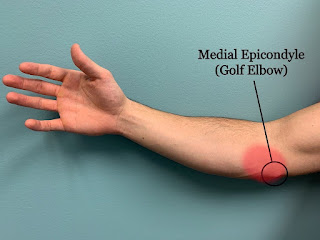
|
All of the flexors of the fingers and the pronators of the forearm insert at the medial epicondyle of the humerus to include: pronator teres, flexor carpi radialis, flexor carpi ulnaris, flexor digitorum superficialis, and palmaris longus.
Pain can be felt during long sessions of not only golf swinging but other sports which include squeezing or pitching a ball, rowing, hammering, painting, shaking hands, turning a doorknob, lifting weights or using tools such as screwdrivers.

Causes
It is caused by stressed or repetitive arm movements, often forceful wrist and finger motions. Gripping objects too tightly or for too long with your hand turned up or in a supinated position will create problem that would lead to golfer’s elbow.
It is also sometimes called pitcher's elbow due to the same tendon being stressed by the throwing of objects such as a basebal.
Over-using of the forearm muscles can put too much strain and lead to minor tears in tendons that attach the muscles to the epicondyles. If these activities continue without allowing the tears to heal, the tendon may become inflamed and this wear and tear process will lead to tissue degeneration.
Degenerated tissues or tendons usually have an abnormal arrangement of collagen fibres which loses its strength and become fragile. Other than that, faulty technique or mechanics, or improper equipment used, as well as lack of warming up or poor exercise conditioning leads to this problem.
Signs and Symptoms of Golfer’s Elbow
•Pain and tenderness over the inner side of the elbow or epicondyle during use of the affected muscles (pronation, wrist flexion and elbow flexion). Pain may appear suddenly or gradually.
•May have a slight swelling.
-Activities worsen the symptoms.
-Stiffness at the elbow and difficult to form a fist.
•Muscles weakness especially of the hand and wrist.
•Numbness, pins and needles or tingling of the fingers. It may radiate into one or more fingers normally the fourth and the little finger.
Diagnosis
To diagnose golfer's elbow, clinicians may apply force to the elbow and wrist. If the subject indicates pain or inability to resist on the medial side, golfer's elbow may be present.

Physiotherapy
•Rest or put your golf game or other repetitive activities on hold until the pain is gone. This will aid in reducing elbow pain
•Icing or ice massage to reduce swelling
•Protect the area by bandaging or bracing to reduce load on your elbow
•Facilitation of tissue repair using modalities such as ultrasound or laser treatment
Kinesiotaping helps by relieving pressure, relaxing muscles and may increase circulation
Stretching, gradual strengthening and flexibility exercise are effective for restoration of normal joint range of motion and normal muscle strength
Use a brace. Your doctor might recommend that you wear a counterforce brace on your affected arm, which might reduce tendon and muscle strain.
Therapy includes a variety of exercises for muscle and tendon reconditioning, starting with stretching and gradual strengthening of the flexor-pronator muscles. Strengthening will slowly begin with isometrics and progresses to eccentric exercises helping to extend the range of motion back to where it once was.
Medication
You can take an over-the-counter pain reliever. Try ibuprofen (Advil, Motrin IB, others), naproxen sodium (Aleve) or acetaminophen (Tylenol, others).
